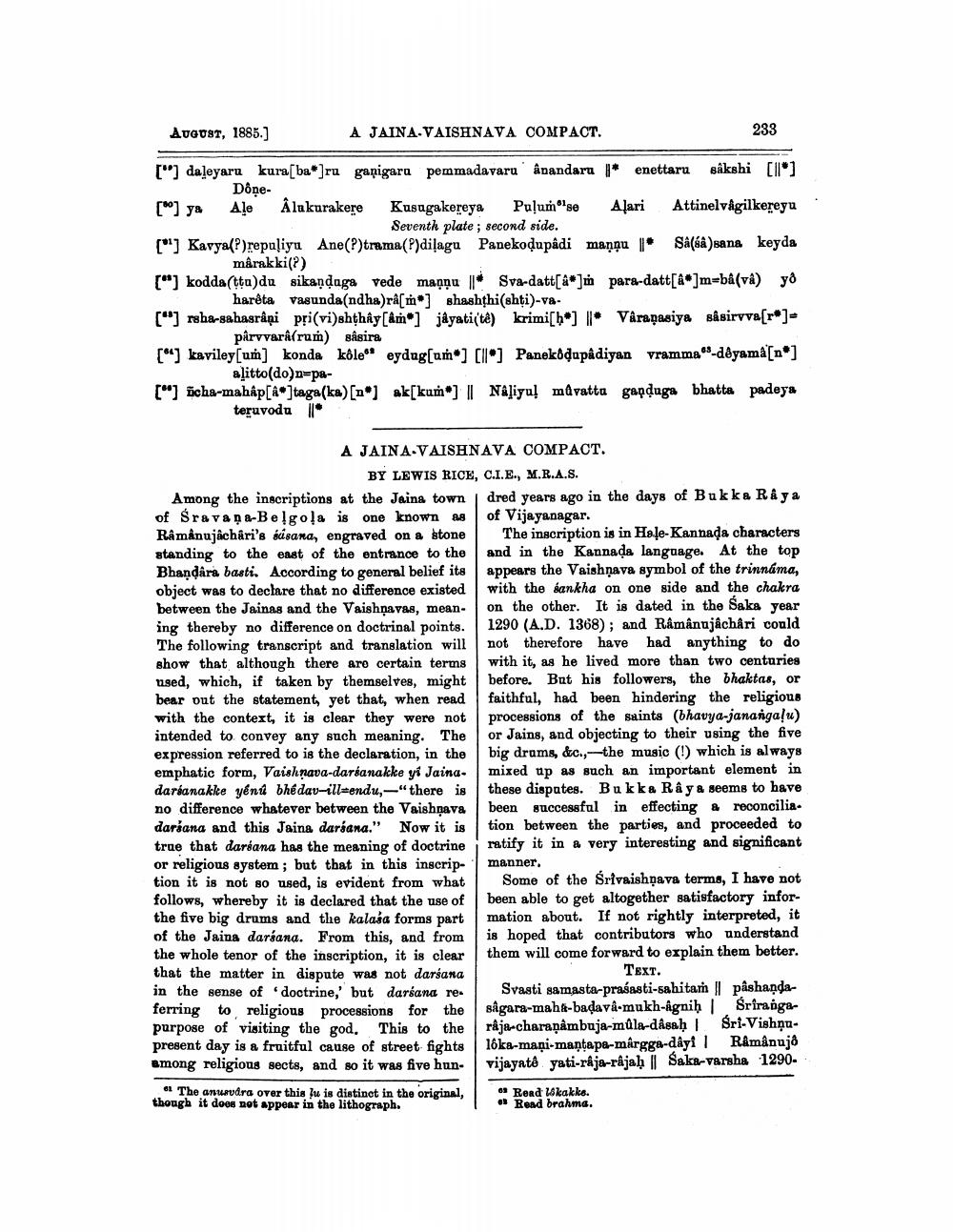________________
AUGUST, 1885.)
A JAINA VAISHNAVA COMPACT.
233
("] daleyarı kura[ba*]ru ganigara pemmadavaru Anandaru * enettaru såkshi [lo]
Dôņe[] ya Aļe Alakurakere Kusugakereya Puļumose Alari Attinelvågilkeregu
Seventh plate ; second side. ("] Kavyal? )repaliyu Ane(?)trama(P)dilagu Panekodupadi mangu | Sâ(sa)sana keyda
mârakki) [*] kodda (ttu)du sikandaga vede maņņu | Sva-datt[a] para-datt[@]m=bâ(va) y8
hareta vasunda(ndha)ra[m] shashthi(shti)-va["] reha-sahasrani pri(vi)shthây[Am] jayati(te) krimi[bo] Il Varanasiya sisirvva[r"]=
pârvvarâ(run) såsira ["] kaviley[um] konda kôle'' eydug[u^*] [ll•] Panekodupadiyan vramma"-döyama[n*]
alitto(do) n=pa["] mcha-mahap[&•]taga(ka)[no) ak[kum] | Naliyu! mavatta gapdaga bhatta padeya
teruvodu il*
A JAINA VAISHNAVA COMPACT.
BY LEWIS RICE, C.I.E., M.R.A.S. Among the inscriptions at the Jaina towndred years ago in the days of Bukka Raya of Sravana-Belgola is one known as of Vijayanagar. Râmánujâchåri's súsana, engraved on a stone The inscription is in Hale-Kannada characters standing to the east of the entrance to the and in the Kannada language. At the top Bhandara basti. According to general belief its appears the Vaishnava symbol of the trinnama, object was to declare that no difference existed with the sankha on one side and the chakra between the Jainas and the Vaishnavas, mean- on the other. It is dated in the Saka year ing thereby no difference on doctrinal points. 1290 (A.D. 1368); and RÂmânujâchåri could The following transcript and translation will not therefore have had anything to do show that although there are certain terms with it, as he lived more than two centuries used, which, if taken by themselves, might before. But his followers, the bhaktas, or bear out the statement, yet that, when read faithful, had been hindering the religious with the context, it is clear they were not processions of the saints (bhavya-janangalu) intended to convey any such meaning. The or Jains, and objecting to their using the five expression referred to is the declaration, in the big drams, &c.,--the music (1) which is always emphatic form, Vaishnava-darianakke yi Jaina. mixed up as such an important element in darsanakke yenu bhé dav-ill=endu, -"there is these disputes. Bukka Rây a seems to have no difference whatever between the Vaishnava been successful in effecting & reconciliadarsana and this Jaina darsana." Now it is tion between the parties, and proceeded to true that darsana has the meaning of doctrine ratify it in a very interesting and significant or religious system ; but that in this inscrip- manner. tion it is not so used, is evident from what Some of the Srivaishộava terms, I have not follows, whereby it is declared that the use of been able to get altogether satisfactory inforthe five big drums and the kalaia forma part mation about. If not rightly interpreted, it of the Jaina darsana. From this, and from is hoped that contributors who understand the whole tenor of the inscription, it is clear them will come forward to explain them better. that the matter in dispute was not darsana
Text. in the sense of doctrine,' but darsana re. Svasti samasta-prasasti-sahitam pashandaferring to religious processions for the sågara-mah-badavâ-mukh-Agnih | Srirangapurpose of visiting the god. This to the râja-charaņâmbaja-mûla-dâsaḥ | Sri-Vishņupresent day is a fruitful cause of street fights 16ka-maņi-mantapa-margga-dâyf | Ramanujo among religious sects, and so it was five hun- vijayato yati-raja-rajah || Saka-Varsha 1290
The anturudra over this {u is distinct in the original, 1 1 though it does not appear in the lithograph.
Read Lokakko. • Read brahma.




